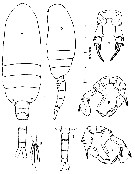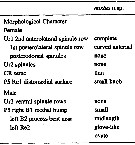|
|
 |
|
Calanoida ( Order ) |
|
|
|
Diaptomoidea ( Superfamily ) |
|
|
|
Pseudodiaptomidae ( Family ) |
|
|
|
Pseudodiaptomus ( Genus ) |
|
|
| |
Pseudodiaptomus mixtus Walter, 1994 (F,M) | |
| | | | | | | Ref.: | | | Walter, 1994 (P.129, figs.F,M) |  Issued from : T. C. Walter in Hydrobiologia, 1994, 292/293. [p.127, Fig.1]. Female (from Kaptai Lake, Bangladesh): A, habitus (dorsal); B, tip of left caudal ramus showing normal setae; C, P5 (anterior view). Male: D, habitus (left lateral view); E, urosome (ventral); F, P5 (posterior view); G, P5 (anterior view). Nota Female: Urosomal segments and caydal rami in proportions 29 : 19 : 21 : 10 : 21 = 100. Nota Male: Urosomal segments and caudal rami in proportions 11 : 20 : 19 : 20 : 10 : 20 = 100.
|
 Issued from : T. C. Walter in Hydrobiologia, 1994, 292/293. [p.128, Table 2]. Pseudodiaptomus mixtus from India: Sex, number of specimens measured, total body length range, mean total body length, mean prosome length, mean urosome length and prosome/urosome ratio of lengths.
Compare with the two species in India P. binghami and lobipes.
|
 Issued from : T. C. Walter in Hydrobiologia, 1994, 292/293. [p.128, Table 1]. Pseudodiaptomus mixtus from Bangladesh: Sex, number of specimens measured, total body length range, mean total body length, mean prosome length, mean urosome length and prosome/urosome ratio of lengths.
Compare with the three species in India P. binghami and lobipes.
| | | | | NZ: | 1 | | |
|
Distribution map of Pseudodiaptomus mixtus by geographical zones
|
| | | | | | | Loc: | | | Bangladesh (Kaptai Lake) | | | | N: | 1 | | | | Lg.: | | | (802) F: 1,14-1,23; M: 0,90-0,96; {F: 1,14-1,23; M: 0,90-0,96} | | | | Rem.: | Incomplete data.
In Lobus species group (forbesi subgroup) after Walter & al. 2006, p.203.
At first it was thought these specimens represented a variant of P. lobipes; however, certain morphological features could also be attibuted to those of P binghami. The type material of the two species is not available. In females of P. mixtus, caudal rami setae are narrow in P. lobipes, though urosomite 2 lacks the dorsal spinule row. The P5 is similar to binghami, but exopodal segment 1 distomedial knob is reduced whereas in lobipes it is repkaced by a notch. In males, the P5 left exopodal segment 2 is glove-like and ovate as in binghami, while the left basis resembles that of lobipes, though medial process is bent at midlength rather than near the apex as in lobipes and binghami. Finally, the right coxa possesses a small medial protrusion, which is larger in binghami but is absent in lobipes (See Table 2, compare with P. lobipes and binghami) | | | Last update : 13/03/2016 | |
|
|
 Any use of this site for a publication will be mentioned with the following reference : Any use of this site for a publication will be mentioned with the following reference :
Razouls C., Desreumaux N., Kouwenberg J. and de Bovée F., 2005-2025. - Biodiversity of Marine Planktonic Copepods (morphology, geographical distribution and biological data). Sorbonne University, CNRS. Available at http://copepodes.obs-banyuls.fr/en [Accessed December 04, 2025] © copyright 2005-2025 Sorbonne University, CNRS
|
|
 |
 |





